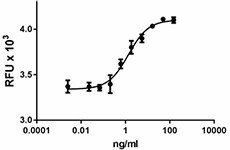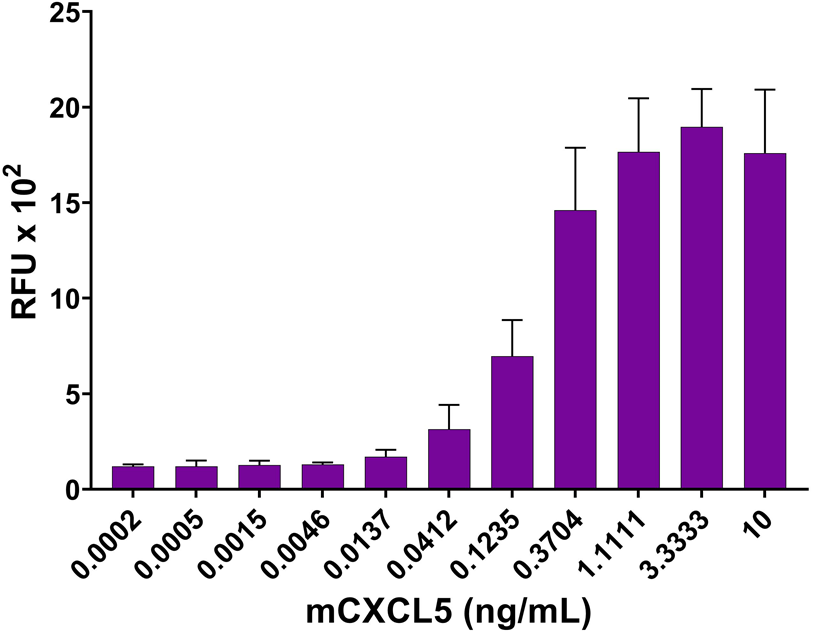- Regulatory Status
- RUO
- Other Names
- Neuregulin-1 β1 (NRG1-β1), Heregulin-1 β1 (HRG1-β1).
- Ave. Rating
- Submit a Review
- Product Citations
- publications

-

Human NRG1-β1 ECD domain induces the proliferation of human mammary epithelium MCF7 cells.
Neuregulin 1 (NRG1) was initially identified in the conditioned medium of a human breast tumor cell line as a protein of 45 kD, which induces the phosphorylation of a tyrosine kinase (ERBB2). The neuregulin family includes four members (NRG1-NRG4) that are encoded from four individual genes. Through differential promoter usage and splicing, these members generate 12 isoforms. The best characterized is neuregulin 1, which includes eight isoforms; all isoforms contain (from N-terminus to C-terminus) an immunoglobulin-like (Ig) domain, a growth factor-like domain (EGF), a transmembrane (TM), and a cytoplasmic domain. Alternative splicing in the EGF-like domain of neuregulin 1 results in α and β isoforms. The EGF-like domain is necessary and sufficient for neuregulin bioactivity. The EGFR family of receptors includes four members (ErbB1 through ErbB4), and neuregulins bind to the ErbB3 and ErbB4 receptors. Neuregulins are released from the membrane by proteolytic cleavage, and this process is required for the binding of the neuregulin derived fragments to ErbB receptors. The neuregulin1-β isoform is predominant in the central nervous system and participates in development, survival, and metabolism in neuron and glial cells. Neuregulin1-β is neuroprotective and attenuates inflammatory responses induced by ischemic stroke in rats, preventing macrophage and microglial infiltration and astrocytic activation. Also, neuregulin1-β blocks the induction of pro-inflammatory and stress genes provoked by ischemia. Neuregulins 1-4 are expressed in approximately 25% of breast cancer carcinomas and increase breast cancer cell proliferation, increase tumorigenesis, and promote invasive characteristics of cancer cells. In this sense, neuregulin1-β induces MMP-1 and MMP-9 in cancer cell lines.
Product DetailsProduct Details
- Source
- Human NRG1-β1 ECD domain, amino acids Ser2-Lys246 (Accession# AAA58639.1), was expressed in E. coli.
- Molecular Mass
- The 245 amino acid recombinant protein has a predicted molecular mass of approximately 26.8 kD. The DTT-reduced and non-reduced protein migrate at approximately 33 kD by SDS-PAGE. The predicted N-terminal amino acid is Ser.
- Purity
- >98%, as determined by Coomassie stained SDS-PAGE.
- Formulation
- 0.22 µm filtered protein solution is in 1x PBS.
- Endotoxin Level
- Less than 0.01 ng per µg cytokine as determined by the LAL method.
- Concentration
- 10-100 µg sizes are bottled at 200 µg/mL. 500 µg and larger sizes are bottled at the concentration indicated on the vial.
- Storage & Handling
- Unopened vial can be stored between 2°C and 8°C for up to 2 weeks, at -20°C for up to six months, or at -70°C or colder until the expiration date. For maximum results, quick spin vial prior to opening. The protein can be aliquoted and stored at -20°C or colder. Stock solutions can also be prepared at 50 - 100 µg/mL in appropriate sterile buffer, carrier protein such as 0.2 - 1% BSA or HSA can be added when preparing the stock solution. Aliquots can be stored between 2°C and 8°C for up to one week and stored at -20°C or colder for up to 3 months. Avoid repeated freeze/thaw cycles.
- Activity
- The ED50 is 1-5 ng/mL, as determined by induction of MCF-7 cell proliferation.
- Application
-
Bioassay
- Application Notes
-
BioLegend carrier-free recombinant proteins provided in liquid format are shipped on blue-ice. Our comparison testing data indicates that when handled and stored as recommended, the liquid format has equal or better stability and shelf-life compared to commercially available lyophilized proteins after reconstitution. Our liquid proteins are verified in-house to maintain activity after shipping on blue ice and are backed by our 100% satisfaction guarantee. If you have any concerns, contact us at tech@biolegend.com.
Antigen Details
- Structure
- Growth factor
- Distribution
-
Gastric epithelial cells, breast cancer cells, fibroblasts, and Schwann cells.
- Function
- Neuregulin 1 plays a key role in embryonic development of the nervous system, heart, and mammary glands. Also regulates the constitutive color and melanocyte function in human skin, and might maintain cardiac structure and function in adults.
- Interaction
- Melanocytes, melanoma cells, epithelial cells, gastric epithelial cells, mesenchymal cells, and Schwann cells.
- Ligand/Receptor
- ErbB3-ErbB2 and ErbB3-ErbB4.
- Cell Type
- Embryonic Stem Cells, Hematopoietic stem and progenitors, Mesenchymal Stem Cells, Neural Stem Cells
- Biology Area
- Cancer Biomarkers, Neuroscience, Stem Cells
- Molecular Family
- Cytokines/Chemokines, Growth Factors
- Antigen References
-
1. Holmes WE, et al. 1992. Sciences 256:1205.
2. Tan W, et al. 2007. J. Biol. Chem. 282:24343.
3. Buac K, et al. 2009. Pigment Cell Melanoma Res. 22:773.
4. Shamir A and Buonanno A. 2010. J. Neurochem. 113:1163.
5. Mei L and Xiong WC. 2008. Nat. Rev. Neurosci. 9:437.
6. Zhang K, et al. 2013. Pigment Cell Melanoma Res. 26:408. - Gene ID
- 3084 View all products for this Gene ID
- UniProt
- View information about NRG1-beta1/HRG1-beta1 on UniProt.org
Related FAQs
- Why choose BioLegend recombinant proteins?
-
• Each lot of product is quality-tested for bioactivity as indicated on the data sheet.
• Greater than 95% Purity or higher, tested on every lot of product.
• 100% Satisfaction Guarantee for quality performance, stability, and consistency.
• Ready-to-use liquid format saves time and reduces challenges associated with reconstitution.
• Bulk and customization available. Contact us.
• Learn more about our Recombinant Proteins. - How does the activity of your recombinant proteins compare to competitors?
-
We quality control each and every lot of recombinant protein. Not only do we check its bioactivity, but we also compare it against other commercially available recombinant proteins. We make sure each recombinant protein’s activity is at least as good as or better than the competition’s. In order to provide you with the best possible product, we ensure that our testing process is rigorous and thorough. If you’re curious and eager to make the switch to BioLegend recombinants, contact your sales representative today!
- What is the specific activity or ED50 of my recombinant protein?
-
The specific activity range of the protein is indicated on the product datasheets. Because the exact activity values on a per unit basis can largely fluctuate depending on a number of factors, including the nature of the assay, cell density, age of cells/passage number, culture media used, and end user technique, the specific activity is best defined as a range and we guarantee the specific activity of all our lots will be within the range indicated on the datasheet. Please note this only applies to recombinants labeled for use in bioassays. ELISA standard recombinant proteins are not recommended for bioassay usage as they are not tested for these applications.
- Have your recombinants been tested for stability?
-
Our testing shows that the recombinant proteins are able to withstand room temperature for a week without losing activity. In addition the recombinant proteins were also found to withstand four cycles of freeze and thaw without losing activity.
- Does specific activity of a recombinant protein vary between lots?
-
Specific activity will vary for each lot and for the type of experiment that is done to validate it, but all passed lots will have activity within the established ED50 range for the product and we guarantee that our products will have lot-to-lot consistency. Please conduct an experiment-specific validation to find the optimal ED50 for your system.
- How do you convert activity as an ED50 in ng/ml to a specific activity in Units/mg?
-
Use formula Specific activity (Units/mg) = 10^6/ ED50 (ng/mL)
 Login/Register
Login/Register 












Follow Us